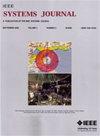基于三种网络视角的信息物理电力系统关键线路和节点评估方法
IF 4.4
3区 计算机科学
Q1 COMPUTER SCIENCE, INFORMATION SYSTEMS
引用次数: 0
摘要
典型的现代电力系统是一个由电力网络和通信网络耦合而成的多层网络,即信息-物理电力系统。以往一些适用于单层网络(如电网)的研究方法已经不适用于目前的cpps。在本文中,我们首先建立了CPPS的电网线路和通信网络节点的重要性评估模型。然后,从网络信息、网络特性和网络结构三个方面对CPPS中的关键节点和关键线路进行评估。从网络信息和网络属性的角度提出了两种算法。并从网络结构角度制定了10项指标。最后,利用Kendall's tau-b分析这三种视角下指标间的相关性结果表明,不同网络中的重要线和重要节点是不同的,基于网络信息视角的信息融合是最有效的重要性评价方法。结果还表明,基于Barabási-Albert通信网络调查CPPS网络节点重要性的研究意义大于基于Watts-Strogatz和Erdös-Rényi网络的分析。研究结果可以很好地了解电力系统的运行状态,有助于降低系统故障的概率,从而为未来的智能和自主电力系统提供支持。本文章由计算机程序翻译,如有差异,请以英文原文为准。
Methods for Evaluating Critical Lines and Nodes in Cyber–Physical Power Systems From Three Network Perspectives
A typical modern power system is a multilayer network consisting of a power network coupled with a communication network, namely, a cyber–physical power system (CPPS). Some previous research methods that were applicable to single-layer networks (such as power networks) are not applicable to current CPPSs. In this article, we first establish an importance evaluation model for the lines in the power network and the nodes in the communication network of a CPPS. Then, the key nodes and lines in the CPPS are evaluated from three perspectives: network information, network properties, and network structure. Two algorithms are proposed, from network information and network property perspectives. Ten indicators are also formulated from a network structure perspective. Finally, the results of analyzing the correlations between indicators under these three perspectives using Kendall's tau-b show that the important lines and nodes in the different networks are different and that the most effective method of importance evaluation is based on information fusion from the network information perspective. The results also show that the research significance of investigating CPPS network node importance based on a Barabási–Albert communication network is greater than that of analyses based on Watts–Strogatz and Erdös–Rényi networks. The results can provide a good understanding of the operating status of a power system to help reduce the probability of system faults, thereby providing support for future intelligent and autonomous power systems.
求助全文
通过发布文献求助,成功后即可免费获取论文全文。
去求助
来源期刊

IEEE Systems Journal
工程技术-电信学
CiteScore
9.80
自引率
6.80%
发文量
572
审稿时长
4.9 months
期刊介绍:
This publication provides a systems-level, focused forum for application-oriented manuscripts that address complex systems and system-of-systems of national and global significance. It intends to encourage and facilitate cooperation and interaction among IEEE Societies with systems-level and systems engineering interest, and to attract non-IEEE contributors and readers from around the globe. Our IEEE Systems Council job is to address issues in new ways that are not solvable in the domains of the existing IEEE or other societies or global organizations. These problems do not fit within traditional hierarchical boundaries. For example, disaster response such as that triggered by Hurricane Katrina, tsunamis, or current volcanic eruptions is not solvable by pure engineering solutions. We need to think about changing and enlarging the paradigm to include systems issues.
 求助内容:
求助内容: 应助结果提醒方式:
应助结果提醒方式:


